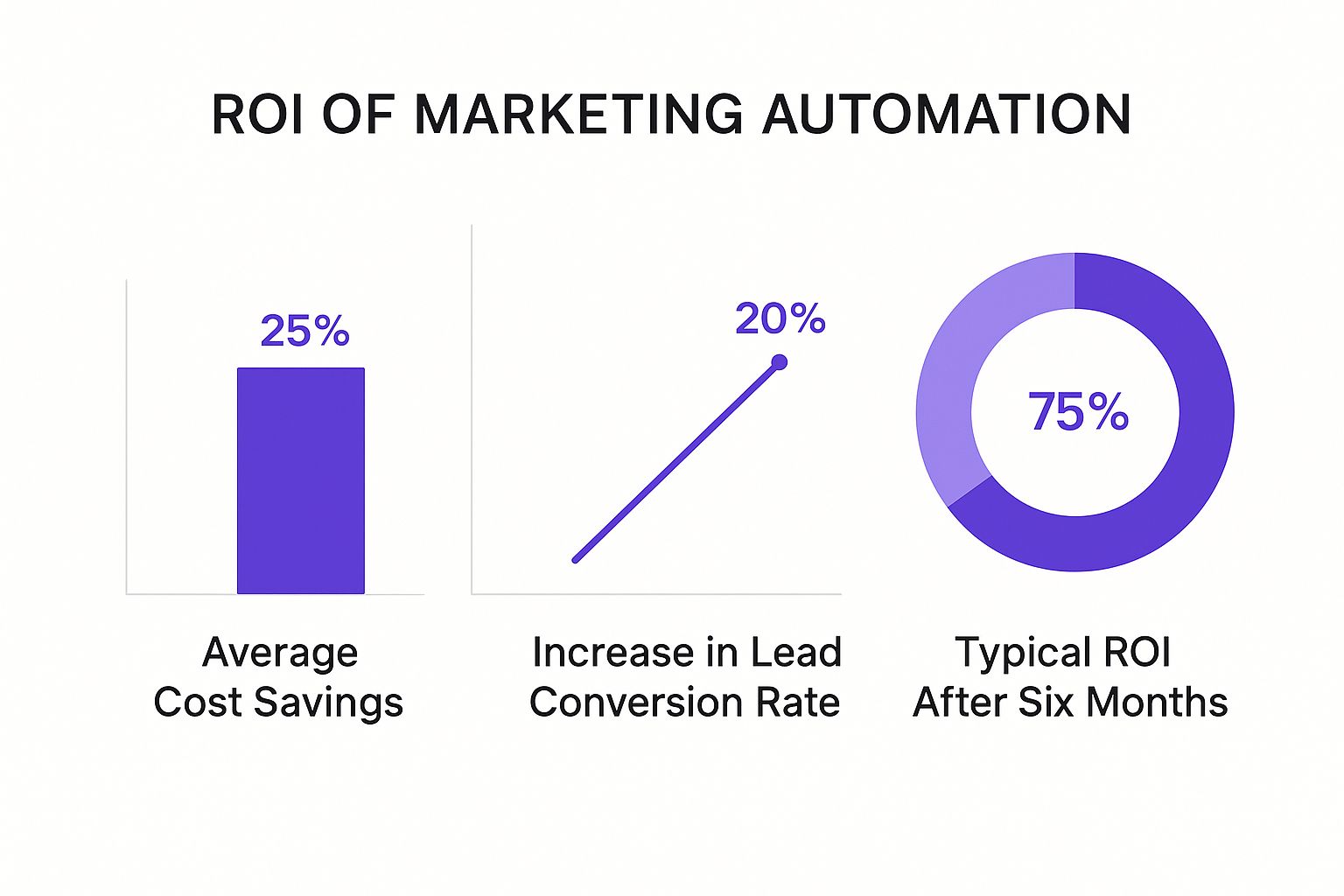ROI of Marketing Automation: Your Complete Measurement Guide
Master the ROI of marketing automation with proven measurement strategies. Learn calculation methods, optimization tactics, and benchmarks that work.
Posted by
Understanding What Marketing Automation ROI Really Means
Calculating the Return on Investment (ROI) of any marketing strategy is crucial, and marketing automation is no exception. Many businesses struggle to accurately gauge the ROI of their automated marketing efforts, often fixating on vanity metrics like open and click-through rates. While these metrics offer a glimpse into engagement, they don't reveal the complete picture. True ROI goes deeper, examining the influence automation has on revenue growth, cost savings, and overall business efficiency.
This requires a shift in perspective, moving past surface-level engagement and focusing on concrete business outcomes. This section will explore how to effectively measure the ROI of marketing automation and why it's vital for sustained success.
Moving Beyond Vanity Metrics
One of the biggest pitfalls businesses encounter is equating opens and clicks with actual returns. For example, a high open rate doesn't automatically translate to increased sales. Similarly, a click might indicate interest, not a purchase commitment.
This means relying solely on these metrics can skew your understanding of your automation performance. Instead, focus on metrics directly impacting the bottom line, such as conversion rates, lead generation, and customer lifetime value. These metrics provide a more accurate view of how automation contributes to revenue growth. You might be interested in: How to master marketing automation for small businesses.
The True Value of Automation
The true ROI of marketing automation encompasses more than just revenue. It also includes the significant impact on operational efficiency. By automating repetitive tasks, businesses free up valuable time and resources, allowing teams to focus on more strategic work.
This boosts productivity and reduces operational costs, both contributing to a higher overall ROI. Moreover, automation facilitates better lead nurturing and personalized customer experiences, building stronger relationships and driving long-term customer loyalty. This long-term value creation is key to understanding the full benefits of marketing automation.
Measuring Long-Term Growth
While short-term gains are important, it's critical to consider the long-term impact of marketing automation. Automation can significantly boost customer lifetime value by nurturing leads and fostering deeper engagement.
This results in increased customer retention and recurring revenue, fueling sustainable growth over time. Tracking customer lifetime value alongside other key metrics provides a comprehensive understanding of your automation ROI. You can then make informed decisions to maximize long-term profitability. The Return on Investment (ROI) of marketing automation is a critical metric for businesses. Companies earn an average of $5.44 for every dollar spent on marketing automation over the first three years. Marketing Automation Statistics. This underscores the potential to increase revenue and improve profits. Furthermore, businesses typically recoup their investment within six months. However, realizing these benefits requires a clear understanding of what ROI truly means and a strategic approach to measurement.
Tracking the Metrics That Actually Drive Revenue

Open rates and click-throughs offer a glimpse into engagement, but they don't tell the whole story about your marketing automation ROI. To truly understand its impact, you need to look beyond these vanity metrics.
Instead, focus on metrics directly tied to revenue growth. This means prioritizing key performance indicators (KPIs) that reflect how automation affects your bottom line. This shift in focus provides a much clearer picture of your success.
Establishing Meaningful Baselines
Before diving into marketing automation, it's essential to understand your current performance. Establishing baselines for crucial metrics like conversion rates, lead generation costs, and customer lifetime value is key.
These baselines become the benchmark against which you measure the effectiveness of your automation efforts. For example, knowing your average cost per lead beforehand helps you track how automation impacts this cost. This gives you a concrete measure of its success.
Identifying the Right KPIs
Choosing the right KPIs is critical for accurately measuring marketing automation ROI. Your chosen metrics should align with your specific business objectives.
If your goal is increased sales, focus on metrics like sales qualified leads and closed deals. If improving customer retention is your priority, then metrics like customer churn rate and customer lifetime value become more important. Aligning your metrics with your goals clarifies automation's influence on your overall strategy.
Monitoring Progress and Identifying Warning Signs
Regularly monitoring your chosen KPIs allows you to track progress and identify any potential obstacles. This proactive approach empowers you to make adjustments and optimize your automation workflows.
Recognizing early warning signs is equally important. A decrease in lead quality or a plateau in conversion rates can signal underlying issues. Addressing these promptly prevents long-term damage to your ROI and ensures your automation program's continued success.
Marketing automation has a proven track record of improving sales productivity and conversion rates. Studies show that these tools can boost sales productivity by 12.2%. Further, 77% of businesses report increased conversion rates after implementing marketing automation. For more statistics, check out this insightful resource: Marketing Automation Statistics.
Structuring Your Measurement Framework
Successful companies build their measurement frameworks to capture the full scope of automation's advantages. This goes beyond simple revenue increases and includes improvements across the entire customer journey.
Tracking metrics like customer engagement, conversion rates at each stage of the sales funnel, and customer lifetime value growth provides a holistic view of automation's impact. This comprehensive understanding allows you to showcase the value of automation to stakeholders and make informed, data-driven decisions to maximize ROI. This, in turn, sets the stage for ongoing improvement and sustained growth.
Calculating Your True Returns Step By Step
Calculating the ROI of marketing automation requires a strategic approach. It's not just about tracking revenue; it's about understanding the full scope of costs and benefits. This includes both short-term gains and the long-term value you create. This section provides a step-by-step guide to accurately assess your marketing automation ROI.
Factoring in All Costs
Calculating the total cost of ownership is crucial. Many businesses only consider the upfront software costs, overlooking other essential expenses. A comprehensive cost analysis should include everything involved in your marketing automation efforts.
- Software Licensing: The recurring cost of your chosen marketing automation platform like HubSpot.
- Implementation & Integration: Costs to set up the platform, integrate it with other systems, and migrate existing data.
- Training & Support: Expenses for training your team and ongoing support fees.
- Content Creation: The cost of developing emails, landing pages, and social media posts.
- Ongoing Optimization & Maintenance: Recurring costs for analyzing data, refining workflows, and system updates.
Measuring the Returns
Calculating returns goes beyond simply tracking revenue from automated campaigns. A truly effective approach considers a wider range of factors impacted by automation.
- Increased Revenue: Track revenue from leads nurtured through automation.
- Cost Savings: Calculate reductions achieved through automation compared to previous manual expenses.
- Improved Conversion Rates: Measure automation’s impact on lead conversion by comparing rates before and after implementation.
- Enhanced Customer Lifetime Value: Assess the long-term impact of automation on customer lifetime value through retention rates and recurring revenue.
- Increased Productivity: Quantify the time saved, allowing your team to focus on more strategic activities.
To illustrate the potential impact of automation, let's look at the data:

As this infographic shows, automation can lead to significant cost savings, improved lead conversion rates, and a strong return on investment in a relatively short time. This demonstrates the power of marketing automation to boost both efficiency and profitability.
Handling Attribution Challenges
Attributing revenue to specific marketing activities can be tricky, especially with multiple channels. Clearly defining how revenue will be attributed to automated campaigns is essential for accurate ROI measurement. Here are a few models to consider:
- First-Touch Attribution: Credits the first interaction a lead has with your automated system.
- Last-Touch Attribution: Credits the final interaction before conversion.
- Multi-Touch Attribution: Distributes credit across multiple touchpoints in the customer journey.
Choosing the right model depends on your business and customer journeys. Using control groups—comparing results against a group that didn’t receive automated marketing—can also help isolate automation's impact and provide a more accurate picture of its effectiveness.
Presenting ROI Data
Communicating ROI data effectively is key for stakeholder buy-in. Present your findings clearly and concisely.
- Use visuals like charts and graphs to showcase key metrics.
- Focus on the most relevant metrics for your stakeholders.
- Explain your calculation methods transparently.
- Emphasize the long-term benefits of automation for business growth.
By following these steps, you can accurately calculate and demonstrate the value of your marketing automation initiatives. This allows for data-driven decisions, informed resource allocation, and ongoing optimization to maximize your returns.
Implementation Strategies That Maximize Your Returns
What separates automation programs that deliver exceptional ROI of marketing automation from those that barely break even? The answer often lies in the implementation strategies. A well-structured approach is essential for maximizing returns from the very beginning. This involves careful planning, phased rollouts, and continuous optimization.
Phased Rollouts for Steady Growth
Imagine trying to learn a complex musical piece all at once. It's overwhelming! The same principle applies to marketing automation implementation. A phased rollout allows your team to gradually adopt the new system, mastering one component at a time.
This reduces the risk of errors and ensures a smoother transition. Start with a pilot program focusing on a specific marketing channel or customer segment. Once you've achieved success, you can expand to other areas. This measured approach builds confidence and expertise, ultimately contributing to a higher ROI.
Team Training and Skill Development
Even the most sophisticated automation platform is ineffective without a skilled team to operate it. Investing in comprehensive training is crucial for success. Equip your team with the knowledge and skills to effectively use the platform’s features.
This empowers them to create targeted campaigns, analyze data, and optimize workflows. A well-trained team extracts maximum value from marketing automation, boosting your ROI. Read also: How to master your marketing automation strategies.
Ongoing Optimization for Peak Performance
Implementation isn't a one-time event; it’s a continuous process. Regularly analyze your automation performance, identifying areas for improvement. This might involve refining workflows, A/B testing different messaging, or adjusting targeting parameters.
Ongoing optimization ensures your automation program continues to thrive, delivering consistent ROI growth over time. Systematically tracking metrics and making data-driven adjustments can significantly improve long-term results. Studies show academics using systematic note-taking spend 40% less time on literature reviews and cite 35% more relevant sources. Learn more about literature review efficiency.
Aligning Implementation With Business Objectives
Your implementation strategy should align with your specific business goals and customer journey characteristics. If your primary objective is lead generation, focus your automation efforts on attracting and nurturing prospects.
If customer retention is key, prioritize automation that enhances customer experience and loyalty. This targeted approach maximizes the impact of automation on your most important business drivers, leading to a stronger ROI. Consider your industry and customer base. What channels do they prefer? What messaging resonates? Tailoring your implementation to these specific needs maximizes your chances of success.
Avoiding Common Pitfalls
Several pitfalls can hinder the ROI of marketing automation. Lack of clear goals can lead to unproductive automation efforts. Insufficient training leaves your team underprepared to effectively use the platform. Neglecting ongoing optimization results in stagnant performance.
By proactively addressing these challenges, you can ensure your automation program delivers its full potential. This involves defining clear objectives, investing in training, and committing to continuous improvement.
How Your ROI Stacks Up Against Industry Standards

Understanding your marketing automation ROI requires context. Knowing how your results compare to industry benchmarks helps you gauge the effectiveness of your strategies and pinpoint areas for potential improvement. This section delves into performance data across various sectors, company sizes, and automation maturity levels to offer that crucial perspective.
Benchmarking Your ROI: Where Do You Stand?
Just like a ship needs a compass, your marketing automation program needs benchmarks to steer its course. Industry standards offer a valuable point of reference, helping you understand where your ROI stands in relation to your competitors. This is especially important when evaluating the effectiveness of your automation investment.
Comparing your performance against established benchmarks reveals your strengths and weaknesses. This awareness is crucial for making smart decisions and optimizing your automation strategies for maximum impact. For example, if your conversion rates are below average, it might be time to refine your lead nurturing workflows.
Unveiling the Drivers of Above-Average ROI
What differentiates high-performing marketing automation programs from the rest? Several factors contribute to exceptional ROI, and understanding these drivers is key to replicating their success. This involves examining elements like strategic alignment, data-driven decision-making, and ongoing optimization.
It’s important to remember that these factors are interconnected and work together to drive results. A holistic approach is essential for achieving above-average ROI. Data analysis is invaluable, but it’s only effective when combined with strategic decision-making and continuous refinement. Learn more in our article about the ROI of social media marketing.
Industry-Specific Strategies for Success
Different industries often require tailored approaches to marketing automation. What works for e-commerce might not be as effective for B2B software sales. This is where sector-specific strategies become crucial for maximizing ROI.
Understanding how other companies in your industry approach ROI measurement offers valuable insights. This includes identifying which metrics they prioritize and the techniques they use to achieve superior results. Adopting these best practices, while adapting them to your specific business needs, can significantly improve your automation ROI.
To help illustrate the varying ROI across different industries and company sizes, let's take a look at the table below:
Marketing Automation ROI by Industry and Company Size
Comparative data showing average ROI performance across different sectors and business scales
| Industry | Average ROI | Payback Period | Top Performing Metric |
|---|---|---|---|
| Retail | 350% | 12 months | Conversion Rate |
| Financial Services | 250% | 18 months | Customer Lifetime Value |
| Healthcare | 200% | 24 months | Lead Generation |
| Technology (SMB) | 400% | 9 months | Sales Qualified Leads |
| Technology (Enterprise) | 150% | 36 months | Customer Retention |
As you can see, the average ROI and key metrics vary significantly between industries and even within the same industry based on company size. Understanding these differences is crucial for setting realistic goals and benchmarks.
Realistic Expectations and Timelines
Setting realistic expectations for your ROI is essential for avoiding disappointment and staying motivated. Marketing automation is a powerful tool, but it’s not a magic bullet. Results take time and effort.
Understanding the typical ROI timelines for your industry and company size helps you gauge your progress and make necessary adjustments. This might involve analyzing historical data, consulting industry reports, and learning from the experiences of other businesses. This allows you to set achievable milestones and celebrate your wins.
Emerging Trends and Future Opportunities
The marketing automation landscape is constantly changing, with new technologies and trends regularly emerging. Staying aware of these advancements is essential for staying competitive and maximizing your ROI.
Artificial intelligence (AI), for instance, is playing an increasingly prominent role in marketing automation. Leveraging AI-powered features within platforms like HubSpot or Marketo can unlock new opportunities for personalization, optimization, and enhanced returns. Embracing these emerging technologies can future-proof your automation efforts and position you for long-term success.
Solving Common ROI Measurement Roadblocks
Measuring the ROI of marketing automation can be tricky. Even with top-notch platforms, it's easy to lose sight of your actual returns. This section tackles those common roadblocks and offers practical solutions to help you get a clearer picture.
Navigating Complex Attribution Scenarios
One of the biggest challenges is attribution. With so many marketing channels, figuring out which interactions led to a conversion can be a puzzle. A customer might see an email, visit your social media, and browse your website before finally buying something. So how do you give each touchpoint the right amount of credit?
This is especially true in B2B sales, where the process can take months and involve several decision-makers. Someone might interact with your content across multiple channels for a long time before they convert. Measuring the impact of automation in these longer journeys requires a smart strategy.
One solution is using multi-touch attribution models. These models spread the credit across different touchpoints based on their influence on the final conversion. For example, a weighted multi-touch model might give more weight to interactions that happened closer to the sale.
Overcoming Data Integration Headaches
Data silos are another common problem. Many businesses use separate systems for different marketing tasks. If your CRM, marketing automation platform, and analytics tools aren't connected, getting a complete view of your performance is nearly impossible.
This lack of integration can skew your ROI calculations. For instance, if your lead data and sales data aren't synced, you might underestimate the conversions from your automated campaigns.
The key is solid data integration. Make sure your marketing automation platform connects seamlessly with your CRM and other systems. This creates a unified data flow, letting you track customer interactions and accurately measure the impact of automation.
Addressing Organizational Resistance
New measurement strategies often mean internal changes. Some team members might resist new tools or processes, especially if they’re used to older methods. This resistance can make it harder to accurately measure ROI.
To overcome this, focus on clear communication and stakeholder buy-in. Explain the benefits of accurate ROI measurement to your team. Show them how the new approach will provide better insights and improve results. Sharing success stories from other companies can also help.
Handling Incomplete Data and System Limitations
Sometimes, you’ll face incomplete data or system limitations. Maybe your tracking isn't capturing every interaction, or your reports aren’t detailed enough.
In these cases, acknowledge the limitations and find workarounds. If you're missing data on some touchpoints, focus on the data you do have. You can also use industry benchmarks and competitor analysis to supplement your data.
Adapting to Changing Business Conditions
External factors, like market shifts or new privacy rules, can also affect your ROI calculations. Your measurement approach needs to be flexible.
Regularly review your framework and adjust as needed. If new privacy regulations limit the data you collect, explore other tracking methods or change your KPIs. This adaptability ensures your ROI measurement stays accurate and relevant.
By tackling these challenges head-on, you can get a much clearer understanding of your marketing automation ROI. This helps you make smarter decisions, optimize campaigns, and maximize your returns. Continuously improving your measurement approach is crucial for long-term success.
Key Takeaways

This practical roadmap outlines key strategies for measuring and maximizing the ROI of your marketing automation efforts. These actionable takeaways can be implemented immediately, helping you optimize returns and avoid common pitfalls.
Focus on the Right Metrics
Don't get bogged down by vanity metrics. While open and click-through rates provide some insights, your focus should be on metrics directly linked to revenue. Track conversion rates, lead generation, customer lifetime value (CLTV), and cost savings. These offer a clearer picture of automation's impact on your bottom line.
For example, if your main goal is to boost sales, focus on tracking sales qualified leads and closed deals. This targeted approach provides a more accurate measurement of your progress.
Calculate Your True ROI
Calculating your true ROI involves more than just tracking revenue generated. It's crucial to factor in all costs, including software, implementation, training, content creation, and ongoing maintenance.
Then, measure the full scope of your returns, from increased revenue and cost savings to improved conversion rates and enhanced CLTV. This comprehensive approach gives you a realistic understanding of your automation investment.
Implement Strategically
A phased rollout allows your team to adapt to new systems and processes, minimizing errors and maximizing efficiency. Invest in proper training so your team can effectively use the marketing automation platform.
Remember that optimization is an ongoing process. Regularly analyze performance, identify areas for improvement, and adapt your workflows for continued success.
Benchmark Against Industry Standards
Comparing your ROI to industry benchmarks offers valuable context. This helps you understand your current position, identify areas for improvement, and learn from successful programs. Research industry-specific best practices and tailor them to your business needs.
For instance, key metrics for retail may differ from those in financial services. Understanding these nuances will help you better interpret your results.
Overcome Measurement Roadblocks
Address common challenges head-on. Develop strategies for navigating complex attribution scenarios, particularly in B2B sales cycles. Ensure seamless data integration between your CRM, marketing automation platform, and other tools. Be prepared to adapt to changing business conditions and privacy regulations.
Future-Proof Your Measurement
The marketing automation landscape is constantly changing. Stay informed about emerging trends, such as the growing role of AI, and explore how new technologies can improve your ROI measurement.
Consider how features like AI-powered personalization can impact your metrics and refine your strategies accordingly. This proactive approach ensures you’re prepared for what lies ahead.
Maximize Your ROI with EndorseFlow
Ready to simplify testimonial collection, boost social media engagement, and unlock the full potential of your marketing automation ROI? EndorseFlow is an all-in-one platform that streamlines these processes. From automated testimonial requests to a unified social media scheduler, EndorseFlow empowers businesses to build credibility, enhance customer trust, and drive higher conversion rates. Discover how EndorseFlow can help you maximize your marketing automation ROI today.